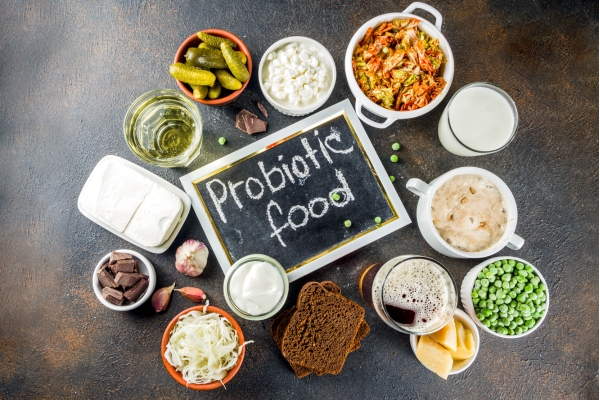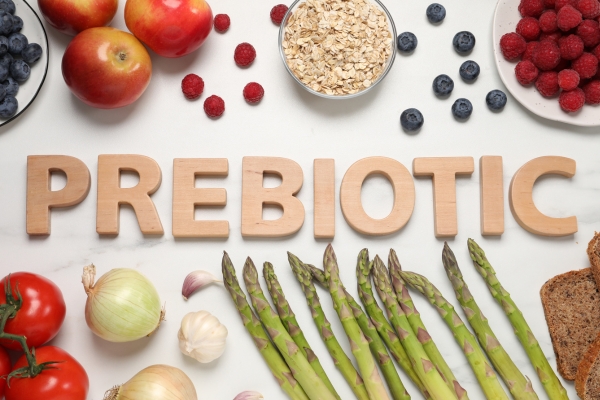Prebiotics vs. Probiotics… two words in nutrition and gut health that can be confusing.
Let’s start with Probiotics – what are they?
Probiotics – the Microbial Heroes.

It’s more than just the food on your plate; it’s a dance of microbes in your gut!
If we were to envision your digestive system as a ballroom, the spotlight would shine on a duo gracefully taking centre stage, performing the perfect dance – the inseparable partners known as pre and probiotics.
We need both pre and probiotics in a delicate balance to maintain a healthy gut – and I promise it’s not as confusing as it might seem.
Probiotics are the unsung heroes of your gut health, the beneficial bacteria that waltz through your digestive system, orchestrating a symphony of well-being.
These living microorganisms, often referred to as the “good bacteria,” take residence in your large colon, lending a helping hand in essential biological tasks.
They defend against inflammation, combat harmful infections, and keep your gut flora thriving! Mother Nature’s probiotics are found in a variety of foods. From miso to sauerkraut to kefir, these friendly microbes help your gut microbiome to thrive.
Now, let’s shift our focus to their dance partners – the prebiotics.
Prebiotics – what are they?
Prebiotics – Nourishing the Microbial Dance.

While probiotics steal the spotlight, let’s not forget about their essential dance partners – prebiotics.
Prebiotics are plant fibres that are not digested by your body but move on down to your lower digestive tract where they are then digested by the good bacteria – your gut microbiome. Yes, it’s these fibres that feed your microbiome so it can flourish and thrive.
These plant-based goodies, including bananas, onions, garlic, and oats, act as the backbone for the microbial community in your gut. They stimulate the growth of the preexisting good bacteria, contributing to the overall health of your digestive system.
How to incorporate both pre and probiotics into your diet.
Probiotics in your diet – what to eat:
- Cultured Delights: For those that tolerate dairy, cultured foods like yogurt, kefir, and fermented cheeses are rich sources of probiotics.
- Fermented Vegetables: Elevate your meals with the vibrant flavours of fermented vegetables. Sauerkraut, kimchi, and naturally fermented pickles are not just side dishes; they’re probiotic powerhouses. Sourdough is considered a fermented food as well.
- Sip on Kombucha: Swap sugary drinks for kombucha, a fizzy, fermented tea. Its tangy taste and probiotic content make it a refreshing choice for nurturing your gut flora.
- Miso Magic: Embrace the umami goodness of miso soup. This traditional Japanese dish, made from fermented soybeans, introduces probiotics while tantalizing your taste buds.
- Kefir Creations: Explore both dairy and non-dairy kefir options. These fermented bevrages are versatile, making them an excellent addition to smoothies or standalone sips.
Prebiotics in your diet – what to eat:
- Plant-Based Powerhouses: Load up on plant-based foods rich in prebiotics. Bananas, onions, garlic, berries, legumes, beans, peas, oats, jerusalem artichokes, asparagus, dandelion greens, leeks, apple skin, and chicory root are among the stars of this microbial performance.
- Fibre: Embrace a diverse range of soluble and insoluble fibres found in these prebiotic-rich foods. The combination of soluble and insoluble fibre provides essential nutrition for the bacteria in your colon.
- Herbs and Spices: Elevate your dishes with herbs and spices, not just for flavour but also for their prebiotic benefits. These culinary wonders act as a medicinal spice drawer for your gut health.
- Fermented Feasts: Integrate fermented foods into your diet as they offer a double benefit – a blend of probiotics and prebiotics. Kimchi, sauerkraut, miso, tempeh, kombucha, kefir, and yogurt are delightful choices for nurturing your gut. Find several fermented food recipes here on this website.
The Dissonance of Gut Imbalance: When the Dance Goes Awry.
Just as a symphony requires harmony, an imbalance in the delicate dance of probiotics and prebiotics can lead to discord in your gut’s microbial composition. When this equilibrium falters, certain strains of bacteria may gain the upper hand, potentially triggering digestive issues, inflammation, and a compromised immune system to name a few.
If you find yourself with what seems like an unbalanced gut, not to worry, chances are, balance can be restored with a few simple steps and your dance routine will be back on beat. Book a free 20 minute session to discuss a personalized plan.
FAQs about Prebiotics and Probiotics:
- What’s the main difference between prebiotics and probiotics? Prebiotics are specialized plant fibers that nourish the good bacteria in your gut, while probiotics are living strains of bacteria that contribute to the population of good bacteria in your digestive system.
- How can I naturally incorporate prebiotics into my diet? Amp up your prebiotic intake with plant-based foods like bananas, onions, garlic, berries, legumes, and oats. These fibers act as food for the good bacteria in your gut, promoting a flourishing microbiome.
- What are some common sources of probiotics, and how can I include them in my meals? Probiotic-rich foods include yogurt, kefir, fermented cheeses, sauerkraut, kimchi, pickles, kombucha, and miso soup. These delicious options can be enjoyed on their own or as creative additions to various dishes.
- Do I need both prebiotics and probiotics, and how do they work together? Yes, a balanced intake of both is essential. Prebiotics act as a food source for the good bacteria introduced by probiotics, creating a harmonious environment in your gut. Together, they contribute to overall digestive health.
- Can I take pre and probiotic supplements, and how do I choose the right ones? Yes, supplements can definitely help you over a digestive hurdle. They are best taken on the advice of a wellness professional. There are many brands, strains and potency options to be considered for your specific situation.
Thank you for joining me on this exploration of the world of prebiotics and probiotics. Writing about nutrition and wellness brings me immense joy, and I’m thrilled to witness the growing interest in embarking on personal wellness journeys. Simply reading this article is an incredible step toward understanding your body’s needs.
If you have questions about your own health journey or if you’re curious to learn more about what I can offer to you, let’s connect during one of my free consults – “The Taste Test”! Click here to schedule your session. Together, let’s craft a plan that nurtures your gut health and unlocks your full potential for well-being.
Cheers to a healthier, happier you!

Need a little pre and probiotic recipe inspiration?
This month’s featured recipe Mushroom Miso Soup, not only satisfies your taste buds but also supports your gut health with a perfect blend of prebiotics and probiotics. Dive into this flavorful creation and give your microbiome a delicious boost. Let the dance of gut-friendly ingredients begin!
